Spatiotemporal Variations in Drought and Wetness from 1965 to 2017 in China
Abstract
1. Introduction
2. Data and Methodology
2.1. Study Area and Data
2.2. Calculation of PET
2.3. Calculation of SPEI
2.4. Mann–Kendall Trend Test for Trend Analysis
2.5. Defining the Drought/Wet Characteristics
3. Results
3.1. Spatial and Temporal Patterns of Annual Trends in SPEI and its Climatic Driving Factors
3.2. Spatial and Temporal Patterns of Seasonal Trends in SPEI
3.3. Trend Analysis of Regional Drought/Wetness at the Annual and Seasonal Timescale
3.4. Temporal Variations of Drought and Wet Characteristics at the Yearly and Seasonally Timescale
3.5. Major Drought Events Identified in Past 53 Years for Each Subregion
3.6. Spatial Patterns of Trends in Drought and Wetness Characteristics
3.7. Spatial Pattern of the Difference of Drought and Wet Characteristics Between Two Periods: 1993–2017 Minus 1965–1992
4. Discussion
4.1. Trends of Drought/Wet Influenced by the Evapotranspiration Calculated Method
4.2. Trends in Drought/Wetness and Its Possible Driving Factors
5. Conclusions
Author Contributions
Funding
Conflicts of Interest
References
- Zhang, Q.; Li, J.; Singh, V.P.; Xu, C.Y. Copula-based spatio-temporal patterns of precipitation extremes in China. Int. J. Climatol. 2013, 33, 1140–1152. [Google Scholar] [CrossRef]
- Vicente-Serrano, S.M.; Azorin-Molina, C.; Sanchez-Lorenzo, A.; Revuelto, J.; Moran-Tejeda, E.; Lopez-Moreno, J.I.; Espejo, F. Sensitivity of reference evapotranspiration to changes in meteorological parameters in Spain (1961–2011). Water Resour. Res. 2014, 50, 8458–8480. [Google Scholar] [CrossRef]
- Milly, P.C.D.; Wetherald, R.T.; Dunne, K.A.; Delworth, T.L. Increasing risk of great floods in a changing climate. Nature 2002, 415, 514–517. [Google Scholar] [CrossRef] [PubMed]
- Cai, W.; Cowan, T.; Briggs, P.; Raupach, M. Rising temperature depletes soil moisture and exacerbates severe drought conditions across southeast Australia. Geophys. Res. Lett. 2009, 36. [Google Scholar] [CrossRef]
- Sternberg, T. Regional drought has a global impact. Nature 2011, 472, 169. [Google Scholar] [CrossRef]
- Wilhite, D.A. Drought as a Natural Hazar—Concepts and Definitions; University of Nebraska: Lincoln, NE, USA, 2000; pp. 3–18. [Google Scholar]
- Yu, M.; Li, Q.; Hayes, M.J.; Svoboda, M.D.; Heim, R.R. Are droughts becoming more frequent or severe in China based on the Standardized Precipitation Evapotranspiration Index: 1951–2010? Int. J. Climatol. 2014, 34, 545–558. [Google Scholar] [CrossRef]
- Yuan, X.; Ma, Z.; Pan, M.; Shi, C. Microwave remote sensing of short-term droughts during crop growing seasons. Geophys. Res. Lett. 2015, 42, 4394–4401. [Google Scholar] [CrossRef]
- Li, K.; Wu, S.; Dai, E.; Xu, Z. Flood loss analysis and quantitative risk assessment in China. Nat. Hazards 2012, 63, 737–760. [Google Scholar] [CrossRef]
- Li, B.; Su, H.; Chen, F.; Wu, J.; Qi, J. The changing characteristics of drought in China from 1982 to 2005. Nat. Hazards 2013, 68, 723–743. [Google Scholar] [CrossRef]
- Wang, Z.; Li, J.; Lai, C.; Zeng, Z.; Zhong, R.; Chen, X.; Zhou, X.; Wang, M. Does drought in China show a significant decreasing trend from 1961 to 2009? Sci. Total Environ. 2017, 579, 314–324. [Google Scholar] [CrossRef]
- Wu, Z.-Y.; Lu, G.-H.; Wen, L.; Lin, C. Reconstructing and analyzing China’s fifty-nine year (1951–2009) drought history using hydrological model simulation. Hydrol. Earth Syst. Sci. 2011, 15, 2881–2894. [Google Scholar] [CrossRef]
- Zou, X.K.; Zhai, P.M.; Zhang, Q. Variations in droughts over China: 1951–2003. Geophys. Res. Lett. 2005, 32. [Google Scholar] [CrossRef]
- Xu, K.; Yang, D.; Yang, H.; Li, Z.; Qin, Y.; Shen, Y. Spatio-temporal variation of drought in China during 1961–2012: A climatic perspective. J. Hydrol. 2015, 526, 253–264. [Google Scholar] [CrossRef]
- McKee, T.B.; Doesken, N.J.; Kleist, J. The relationship of drought frequency and duration to time scales. In Proceedings of the 8th Conference on Applied Climatology, Anaheim, CA, USA, 17–22 January 1993; pp. 179–183. [Google Scholar]
- Zeng, Z.; Wu, W.; Li, Z.; Zhou, Y.; Guo, Y.; Huang, H. Agricultural Drought Risk Assessment in Southwest China. Water 2019, 11. [Google Scholar] [CrossRef]
- Stark, J.; Love, S.; King, B.; Marshall, J.; Bohl, W.; Salaiz, T. Potato cultivar response to seasonal drought patterns. Am. J. Potato Res. 2013, 90, 207–216. [Google Scholar] [CrossRef]
- Alamgir, M.; Mohsenipour, M.; Homsi, R.; Wang, X.; Shahid, S.; Shiru, M.S.; Alias, N.E.; Yuzir, A. Parametric assessment of seasonal drought risk to crop production in Bangladesh. Sustainability 2019, 11, 1442. [Google Scholar] [CrossRef]
- Vicente-Serrano, S.M.; Beguería, S.; López-Moreno, J.I. A multiscalar drought index sensitive to global warming: the standardized precipitation evapotranspiration index. J. Clim. 2010, 23, 1696–1718. [Google Scholar] [CrossRef]
- Sheffield, J.; Wood, E.F.; Roderick, M.L. Little change in global drought over the past 60 years. Nature 2012, 491, 435. [Google Scholar] [CrossRef]
- Chen, H.; Sun, J. Changes in drought characteristics over China using the standardized precipitation evapotranspiration index. J. Clim. 2015, 28, 5430–5447. [Google Scholar] [CrossRef]
- Zhang, K.-X.; Pan, S.-M.; Zhang, W.; Xu, Y.-H.; Cao, L.-G.; Hao, Y.-P.; Wang, Y. Influence of climate change on reference evapotranspiration and aridity index and their temporal-spatial variations in the Yellow River Basin, China, from 1961 to 2012. Quat. Int. 2015, 380, 75–82. [Google Scholar] [CrossRef]
- Wang, Z.; Ye, A.; Wang, L.; Liu, K.; Cheng, L. Spatial and temporal characteristics of reference evapotranspiration and its climatic driving factors over China from 1979–2015. Agric. Water Manag. 2019, 213, 1096–1108. [Google Scholar] [CrossRef]
- Liu, X.; Zhang, D. Trend analysis of reference evapotranspiration in Northwest China: The roles of changing wind speed and surface air temperature. Hydrol. Process. 2013, 27, 3941–3948. [Google Scholar] [CrossRef]
- Allen, R.G.; Pereira, L.S.; Raes, D.; Smith, M. Crop evapotranspiration-Guidelines for computing crop water requirements-FAO Irrigation and drainage paper 56. FaoRome 1998, 300, D05109. [Google Scholar]
- Gocic, M.; Trajkovic, S. Analysis of changes in meteorological variables using Mann-Kendall and Sen’s slope estimator statistical tests in Serbia. Glob. Planet. Chang. 2013, 100, 172–182. [Google Scholar] [CrossRef]
- Gao, X.; Zhao, Q.; Zhao, X.; Wu, P.; Pan, W.; Gao, X.; Sun, M. Temporal and spatial evolution of the standardized precipitation evapotranspiration index (SPEI) in the Loess Plateau under climate change from 2001 to 2050. Sci. Total Environ. 2017, 595, 191–200. [Google Scholar] [CrossRef] [PubMed]
- Leng, G.; Tang, Q.; Rayburg, S.J.G.; Change, P. Climate change impacts on meteorological, agricultural and hydrological droughts in China. Global Planet. Change 2015, 126, 23–34. [Google Scholar] [CrossRef]
- Hu, Q.; Willson, G.D. Effects of temperature anomalies on the Palmer Drought Severity Index in the central United States. Int. J. Climatol. 2000, 20, 1899–1911. [Google Scholar] [CrossRef]
- Sun, S.; Chen, H.; Ju, W.; Wang, G.; Sun, G.; Huang, J.; Ma, H.; Gao, C.; Hua, W.; Yan, G. On the coupling between precipitation and potential evapotranspiration: contributions to decadal drought anomalies in the Southwest China. Clim. Dyn. 2017, 48, 3779–3797. [Google Scholar] [CrossRef]
- Wang, W.; Shao, Q.; Peng, S.; Xing, W.; Yang, T.; Luo, Y.; Yong, B.; Xu, J. Reference evapotranspiration change and the causes across the Yellow River Basin during 1957-2008 and their spatial and seasonal differences. Water Resour. Res. 2012, 48. [Google Scholar] [CrossRef]
- Zhang, Y.; Liu, C.; Tang, Y.; Yang, Y. Trends in pan evaporation and reference and actual evapotranspiration across the Tibetan Plateau. J. Geophys. Res. Atmos. 2007, 112. [Google Scholar] [CrossRef]
- Jhajharia, D.; Dinpashoh, Y.; Kahya, E.; Singh, V.P.; Fakheri-Fard, A. Trends in reference evapotranspiration in the humid region of northeast India. Hydrol. Process. 2012, 26, 421–435. [Google Scholar] [CrossRef]
- Burn, D.H.; Hesch, N.M. Trends in evaporation for the Canadian prairies. J. Hydrol. 2007, 336, 61–73. [Google Scholar] [CrossRef]
- Moonen, A.; Ercoli, L.; Mariotti, M.; Masoni, A.J.A. Climate change in Italy indicated by agrometeorological indices over 122 years. Agric. For. Meteorol. 2002, 111, 13–27. [Google Scholar] [CrossRef]
- Roderick, M.L.; Farquhar, G.D. Changes in New Zealand pan evaporation since the 1970s. Int. J. Climatol. 2005, 25, 2031–2039. [Google Scholar] [CrossRef]
- Roderick, M.L.; Farquhar, G.D. The cause of decreased pan evaporation over the past 50 years. Science 2002, 298, 1410–1411. [Google Scholar] [PubMed]
- Gao, G.; Chen, D.; Ren, G.; Chen, Y.; Liao, Y. Spatial and temporal variations and controlling factors of potential evapotranspiration in China: 1956–2000. J. Geogr. Sci. 2006, 16, 3–12. [Google Scholar] [CrossRef]
- Jin, L.; Fu, J.; Chen, F. Spatial Differences of Precipitation over Northwest China During the Last 44 Years and Its Response to Global Warming. Sci. Geogr. Sin. 2005, 25, 567–572. [Google Scholar]
- Yao, T.; Ren, J.; Xu, B. Map of Glaciers and Lakes on the Tibetan Plateau and the Surroundings; Xi’an Cartographic Publishing House: Xi’an, China, 2008. [Google Scholar]
- Huang, X.; Deng, J.; Wang, W.; Feng, Q.; Liang, T. Impact of climate and elevation on snow cover using integrated remote sensing snow products in Tibetan Plateau. Remote Sens. Environ. 2017, 190, 274–288. [Google Scholar] [CrossRef]
- Zhang, B.; He, C.; Burnham, M.; Zhang, L. Evaluating the coupling effects of climate aridity and vegetation restoration on soil erosion over the Loess Plateau in China. Sci. Total Environ. 2016, 539, 436–449. [Google Scholar] [CrossRef]
- Qiu, Y.; Cai, W.; Guo, X.; Pan, A. Dynamics of Late Spring Rainfall Reduction in Recent Decades over Southeastern China. J. Clim. 2009, 22, 2240–2247. [Google Scholar] [CrossRef]
- Sun, X.; Renard, B.; Thyer, M.; Westra, S.; Lang, M. A global analysis of the asymmetric effect of ENSO on extreme precipitation. J. Hydrol. 2015, 530, 51–65. [Google Scholar] [CrossRef]
- Trenberth, K.E.; Dai, A.; Van Der Schrier, G.; Jones, P.D.; Barichivich, J.; Briffa, K.R.; Sheffield, J. Global warming and changes in drought. Nat. Clim. Chang. 2014, 4, 17. [Google Scholar] [CrossRef]
- Wang, L.; Chen, W.; Huang, R. Interdecadal modulation of PDO on the impact of ENSO on the east Asian winter monsoon. Geophys. Res. Lett. 2008, 35. [Google Scholar] [CrossRef]
- Wang, B.; Wu, R.G.; Fu, X.H. Pacific-East Asian teleconnection: how does ENSO affect East Asian climate? J. Clim. 2000, 13, 1517–1536. [Google Scholar] [CrossRef]
- Xu, Z.; Li, J.; Takeuchi, K.; Ishidaira, H. Long-term trend of precipitation in China and its association with the El Niño–southern oscillation. Hydrol. Process. Int. J. 2007, 21, 61–71. [Google Scholar] [CrossRef]
- Zhang, W.; Jin, F.-F.; Zhao, J.-X.; Qi, L.; Ren, H.-L. The possible influence of a nonconventional El Niño on the severe autumn drought of 2009 in Southwest China. J. Clim. 2013, 26, 8392–8405. [Google Scholar] [CrossRef]
- Toreti, A.; Xoplaki, E.; Maraun, D.; Kuglitsch, F.G.; Wanner, H.; Luterbacher, J. Characterisation of extreme winter precipitation in Mediterranean coastal sites and associated anomalous atmospheric circulation patterns. Nat. Hazards Earth Syst. Sci. 2010, 10, 1037–1050. [Google Scholar] [CrossRef]
- Horton, D.E.; Johnson, N.C.; Singh, D.; Swain, D.L.; Rajaratnam, B.; Diffenbaugh, N.S. Contribution of changes in atmospheric circulation patterns to extreme temperature trends. Nature 2015, 522, 465. [Google Scholar] [CrossRef]
- He, S.; Wang, H. Oscillating Relationship between the East Asian Winter Monsoon and ENSO. J. Clim. 2013, 26, 9819–9838. [Google Scholar] [CrossRef]
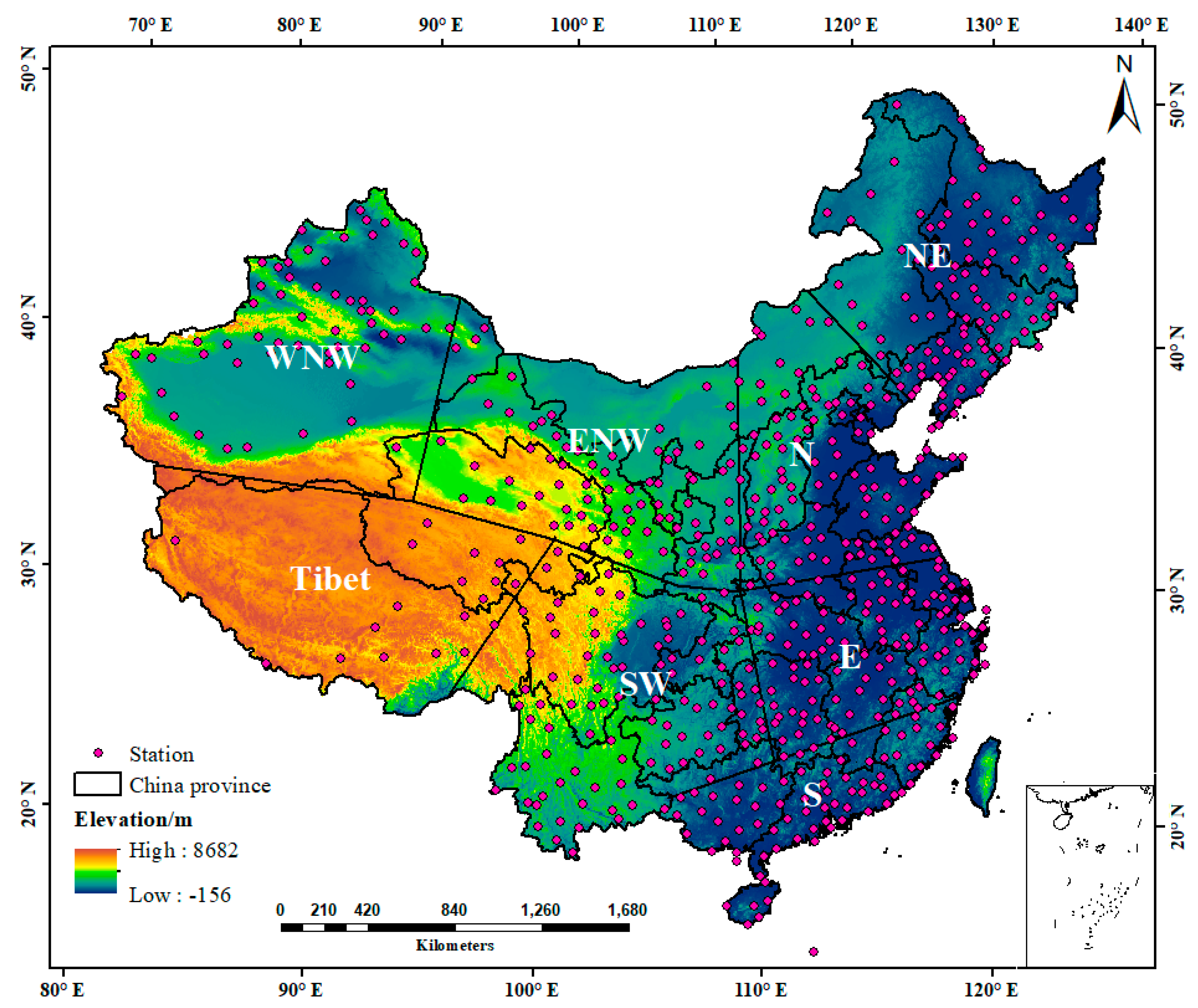
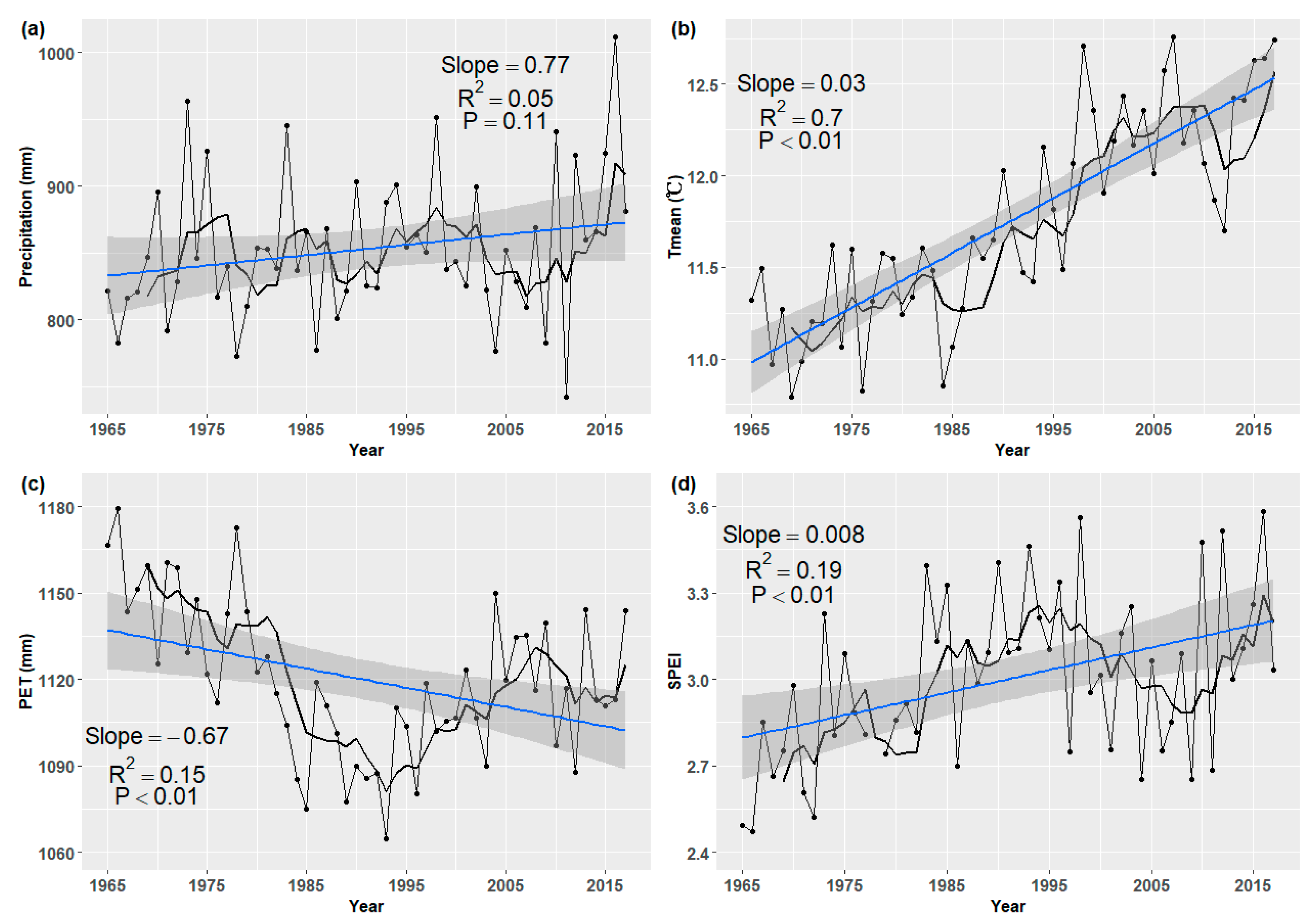
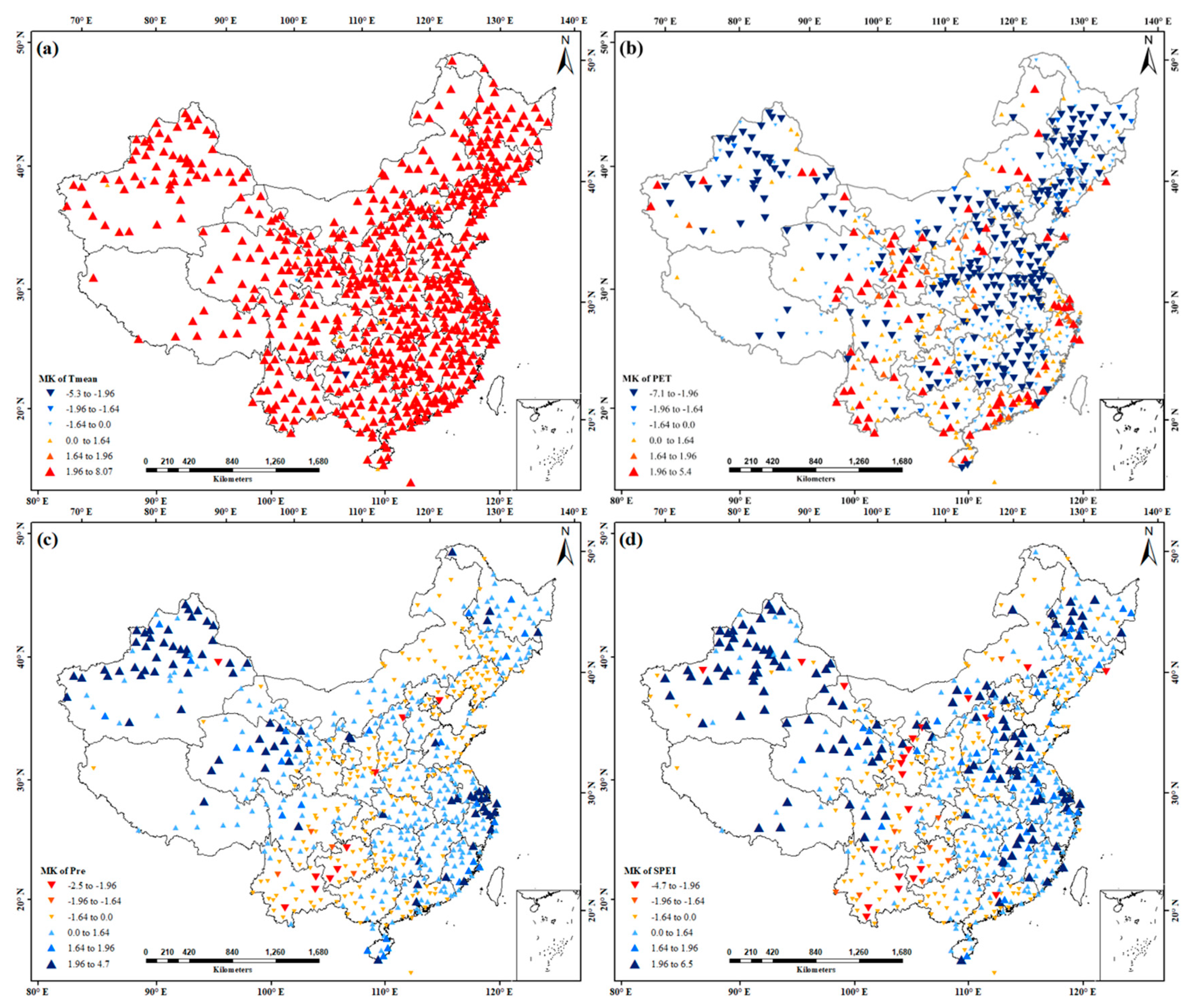



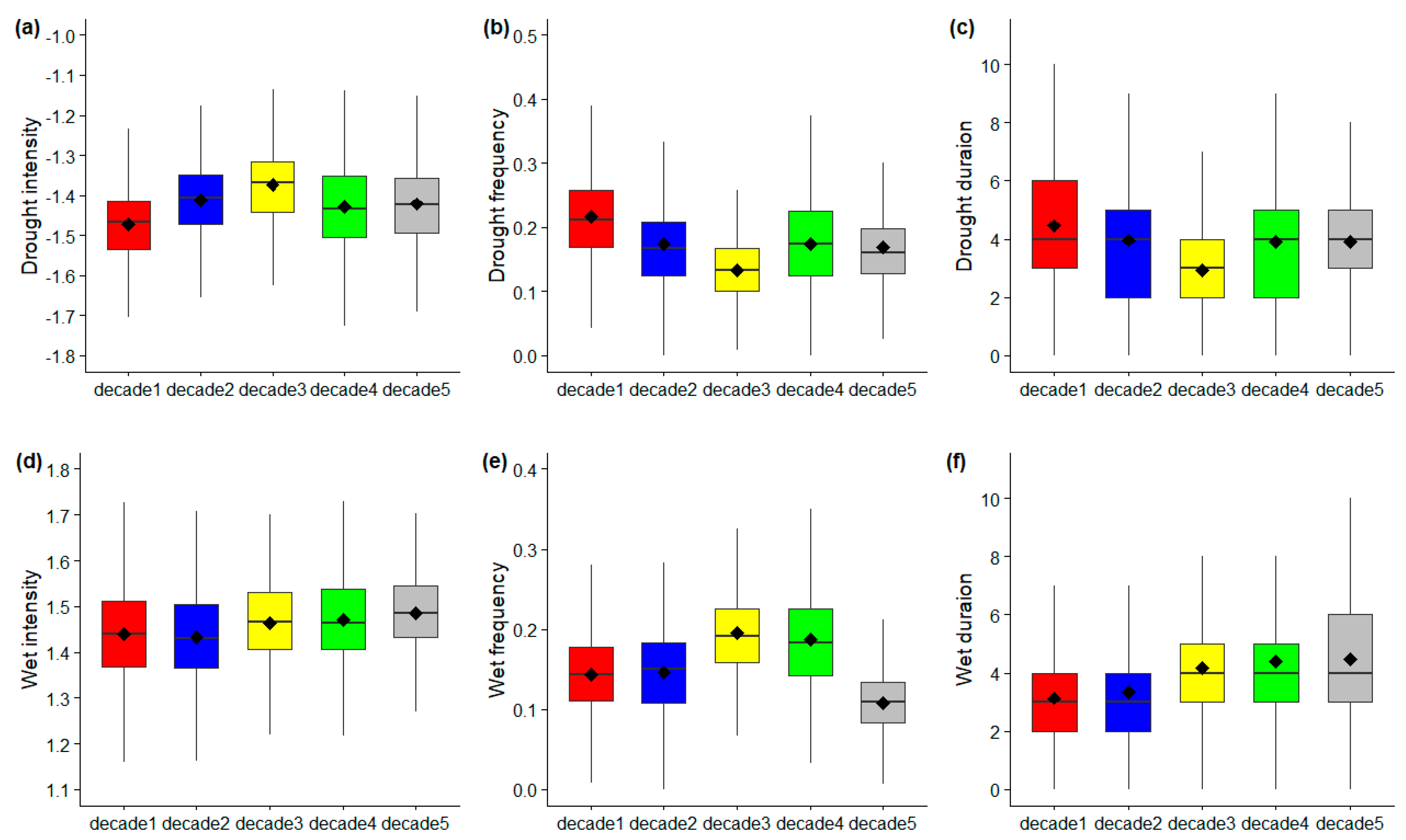
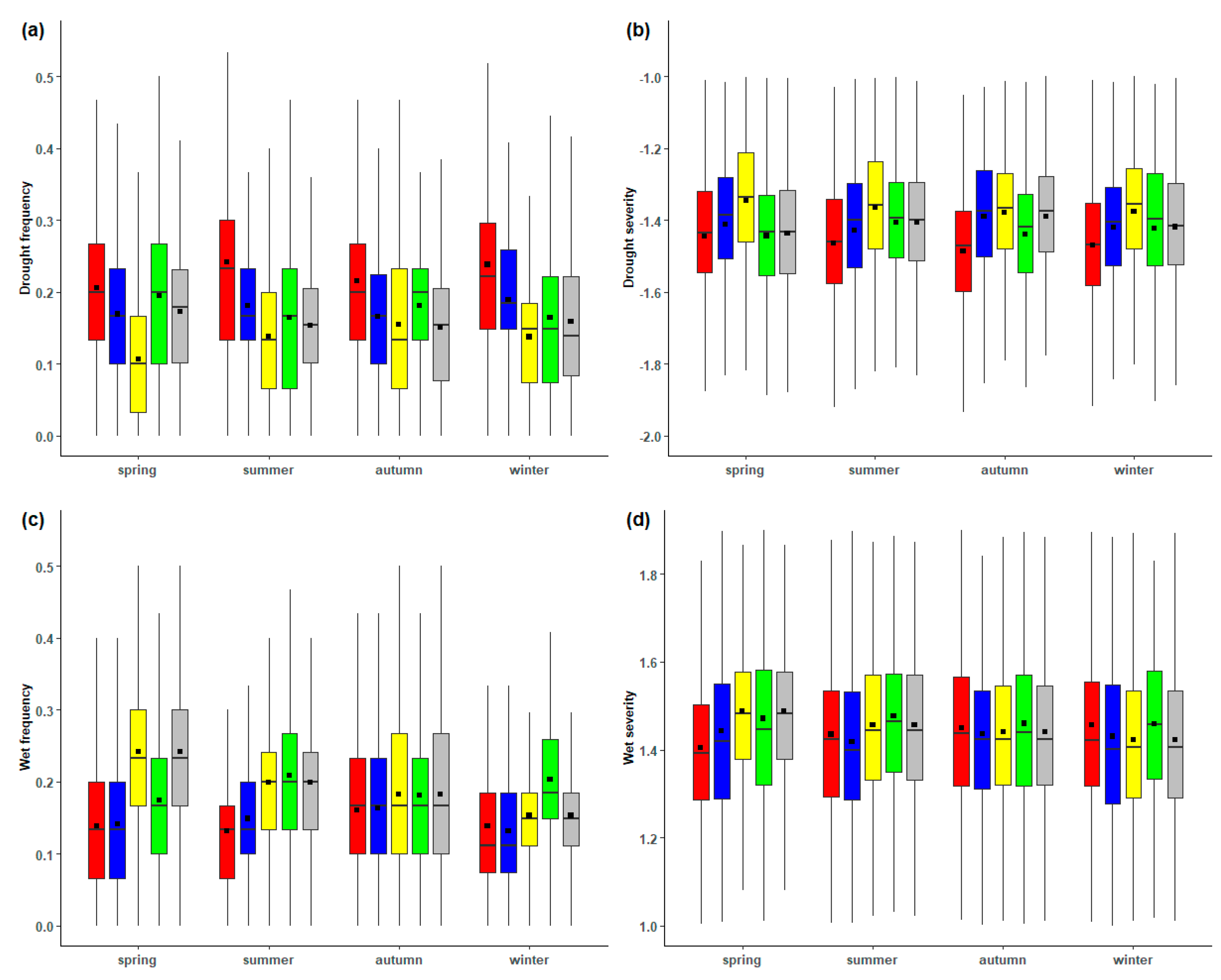
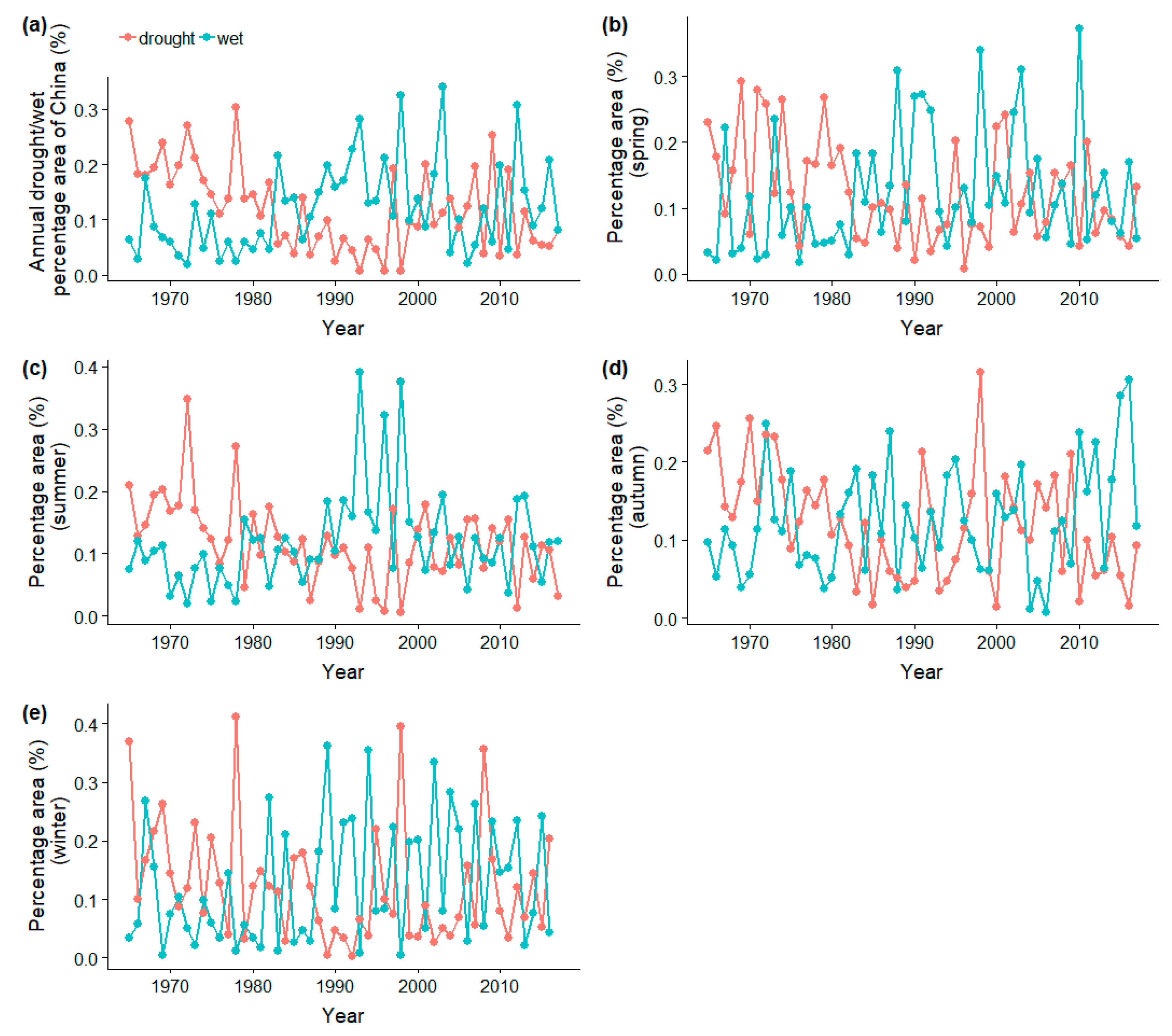

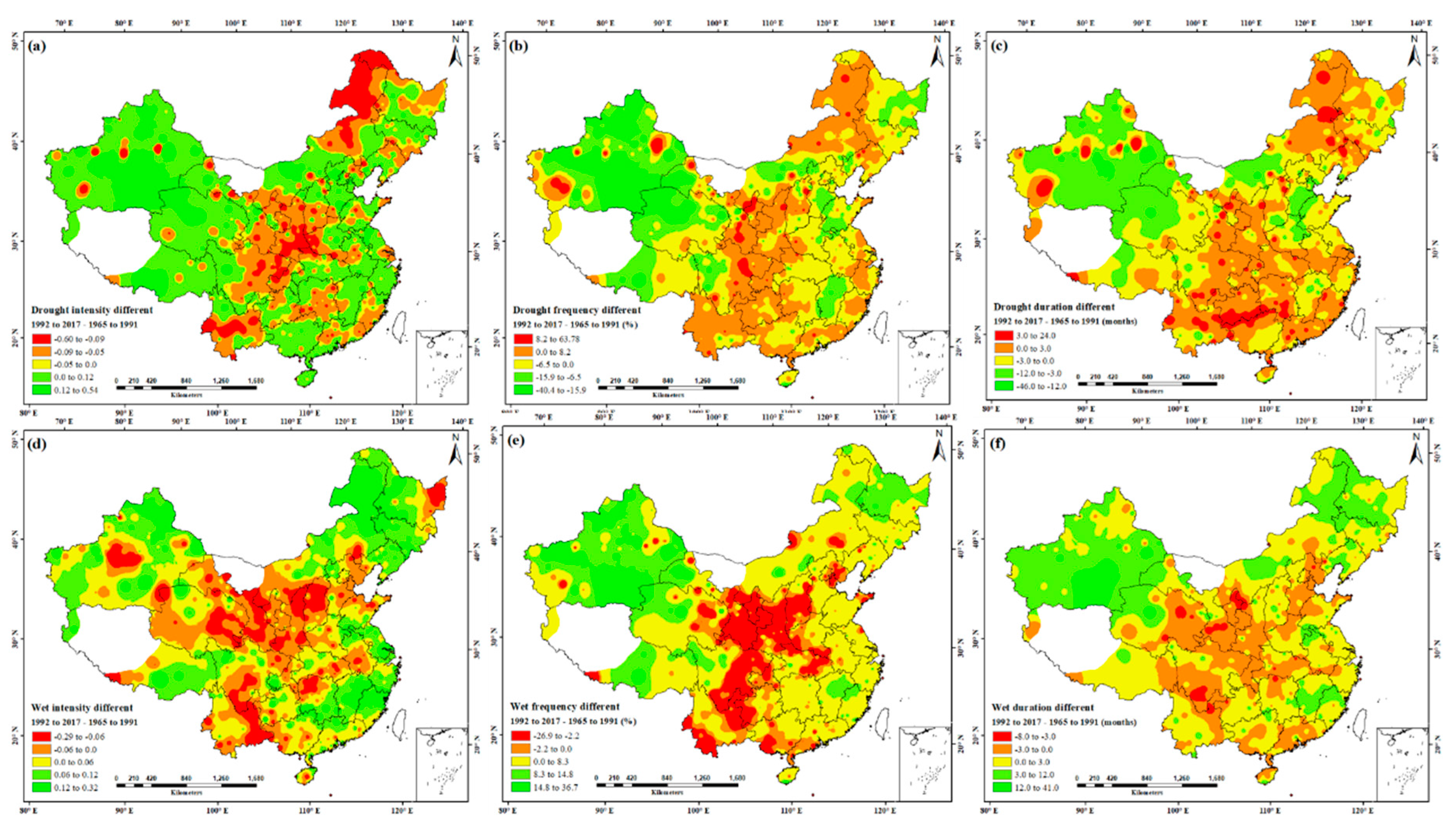
| SPEI | Severity |
|---|---|
| [2.0, +∞) | Very severe wet |
| [1.5, 2.0) | Severe wet |
| [1.0, 1.5) | Moderate wet |
| (−1.0, 1] | Near normal |
| (−1.5, −1.0] | Moderate drought |
| (−2.0, −1.5] | Severe drought |
| (−∞, −2] | Very severe drought |
| Region | Spring | Summer | Autumn | Winter |
|---|---|---|---|---|
| WNW | 0.003 | 0.013 ** | 0.007 * | 0.009 * |
| Tibet | 0.001 | 0.0009 | −0.005 | −0.0009 |
| SW | −0.0005 | 0.0007 | −0.0065 * | −0.0005 |
| S | −0.0009 | 0.004 | 0.0035 | 0.007 |
| NE | 0.013* | 0.0015 | 0.003 | 0.015 * |
| N | 0.003 | 0.003 | 0.01 * | 0.005 |
| ENW | −0.0008 | 0.009 * | 0.008 | 0.004 |
| E | −0.008 | 0.015 ** | 0.005 | 0.0075 |
| Region | Rank | Persistent Period (yyyy.mm) | Duration (month) | Intensity | Centroid (lon: ° E, lat: ° N) |
|---|---|---|---|---|---|
| WNW | 1 | 2013.09–2015.12 | 28 | −1.68 | 84.25, 41.78 |
| 2 | 1969.05–1971.5 | 25 | −1.6 | 87.7, 40.63 | |
| 3 | 2016.01–2017.12 | 24 | −2.26 | 89.2, 42.93 | |
| Tibet | 1 | 1971.09–1972.09 | 13 | −1.57 | 92.07, 31.48 |
| 2 | 1973.01–1974.12 | 12 | −1.51 | 95.6, 31.42 | |
| 3 | 1974.11–1975.08 | 10 | −1.93 | 91.77, 29.25 | |
| SW | 1 | 2012.02–2013.04 | 15 | −1.51 | 102.6, 24.35 |
| 2 | 1980.12–1982.01 | 14 | −1.54 | 101.98, 23.6 | |
| 3 | 2009.10–2010.10 | 12 | −1.84 | 102.27, 27.9 | |
| S | 1 | 1998.08–1999.07 | 12 | −1.67 | 113.05, 23.67 |
| 2 | 2003.03–2004.02 | 12 | −1.46 | 119.28, 26.08 | |
| 3 | 1977.03–1978.01 | 11 | −1.81 | 110.03, 18.5 | |
| NE | 1 | 2001.07–2002.11 | 17 | −1.6 | 122.83, 41.98 |
| 2 | 1975.04–1976.03 | 12 | −1.5 | 130.28, 46.82 | |
| 3 | 1967.01–1967.12 | 12 | −1.45 | 131.15, 44.38 | |
| N | 1 | 1998.08–1999.08 | 13 | −1.8 | 113.53, 39.03 |
| 2 | 2017.01–2018.12 | 12 | −1.94 | 114.95, 44.02 | |
| 3 | 2013.03–2014.01 | 11 | −1.71 | 111.6, 33.78 | |
| ENW | 1 | 1966.01–1969.01 | 37 | −1.64 | 93.52, 42.82 |
| 2 | 1974.12–1976.08 | 21 | −1.49 | 109.85, 40.67 | |
| 3 | 2005.06–2006.10 | 17 | −1.48 | 104.68, 36.57 | |
| E | 1 | 1967.06–1968.04 | 11 | −1.7 | 122.1, 30.03 |
| 2 | 1976.06–1977.03 | 10 | −1.44 | 110.42, 33 | |
| 3 | 2011.12–2012.09 | 10 | −1.38 | 114.1, 31.57 |
© 2020 by the authors. Licensee MDPI, Basel, Switzerland. This article is an open access article distributed under the terms and conditions of the Creative Commons Attribution (CC BY) license (http://creativecommons.org/licenses/by/4.0/).
Share and Cite
Zeng, Z.; Wu, W.; Li, Y.; Zhou, Y.; Zhang, Z.; Zhang, S.; Guo, Y.; Huang, H.; Li, Z. Spatiotemporal Variations in Drought and Wetness from 1965 to 2017 in China. Water 2020, 12, 2097. https://doi.org/10.3390/w12082097
Zeng Z, Wu W, Li Y, Zhou Y, Zhang Z, Zhang S, Guo Y, Huang H, Li Z. Spatiotemporal Variations in Drought and Wetness from 1965 to 2017 in China. Water. 2020; 12(8):2097. https://doi.org/10.3390/w12082097
Chicago/Turabian StyleZeng, Zhaoqi, Wenxiang Wu, Yamei Li, Yang Zhou, Zhengtao Zhang, Shuilong Zhang, Yahui Guo, Han Huang, and Zhaolei Li. 2020. "Spatiotemporal Variations in Drought and Wetness from 1965 to 2017 in China" Water 12, no. 8: 2097. https://doi.org/10.3390/w12082097
APA StyleZeng, Z., Wu, W., Li, Y., Zhou, Y., Zhang, Z., Zhang, S., Guo, Y., Huang, H., & Li, Z. (2020). Spatiotemporal Variations in Drought and Wetness from 1965 to 2017 in China. Water, 12(8), 2097. https://doi.org/10.3390/w12082097







